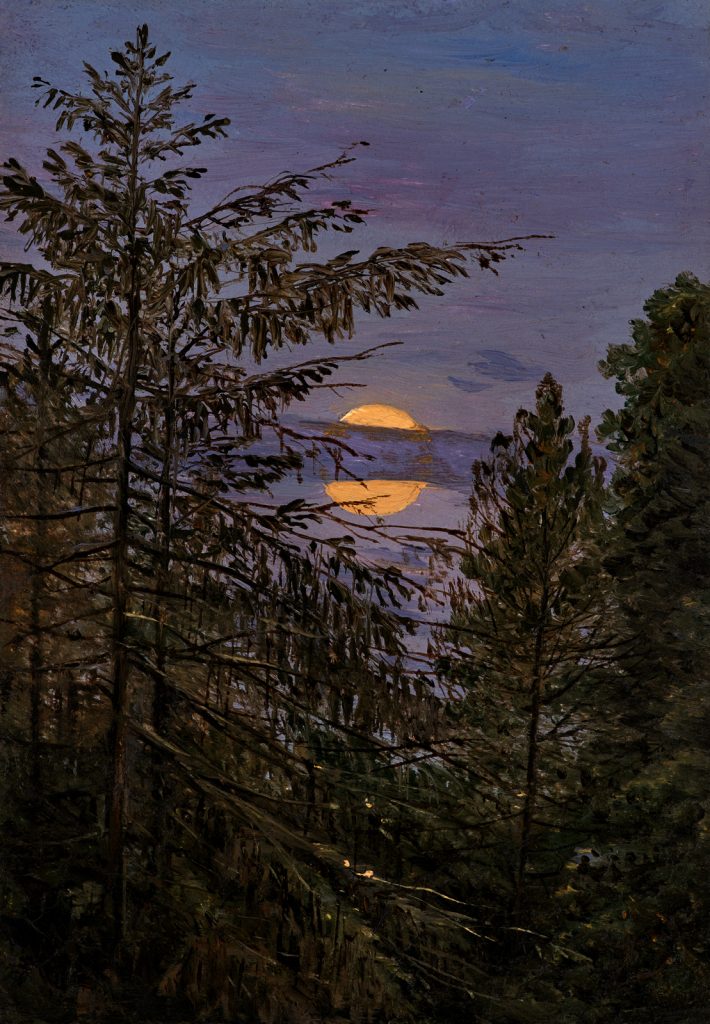Carl Gustav Carus
(Leipzig 1789 - 1869 Dresden)
Rising Moon and Pines
Oil on paper mounted on cardboard, 11.3 x 7.8 cm
Provenance:
- probably Kunsthandlung Rusch, Dresden (by 1930);
- probably Kunsthandel Luz, Berlin (by WWII);
- private collection, Liechtenstein (documented 1995-2009);
- private collection, Switzerland.
Exhibited:
- Dresden, Kunstausstellung Kühl (label on the verso);
- Nuremberg, Germanisches Nationalmuseum (inv. Gm 2060), on long-term loan from a private collection (1995-2009).
Carl Gustav Carus’s small-format night painting depicts the motif of a full moon rising behind pine and fir trees – images of the moon and the emotional power attributed to it are key themes of Romanticism in Dresden. The fading glow of sunset tinges the night sky with delicate shades of violet. A broad band of cloud partly obscures the face of the moon. The soft residual light of the ‘blue hour’ momentarily brings out the structure of the surrounding conifers and gives them depth, lending the small painting an added dimension independent of both form and subject. The concentrated focus on precise observation of nature for which Carus is celebrated incorporates a metaphysical component which is also found in the work of his contemporary Caspar David Friedrich.
Depictions of moonlight and the night sky are leitmotifs in Carus’s oeuvre.[1] He devotes a whole chapter of his theoretical writings – Briefe über Landschaftsmalerei – to what he describes as ‘moonlight pictures’.[2] Personal physician to the Saxon royal family and at the same time natural scientist, philosopher, physiologist and respected landscapist, he reveals himself in his writings as a highly intelligent art theoretician.[3] Taking the Romantic synthesis of ‘sentiment’ and ‘nature’, he sought to combine this with a determination to objectify the representation of nature. His representation of a rising moon therefore contained – in addition to aesthetic elaboration – a precise study of the conditions of light and color – namely, as he writes, ‘the manner in which [the rising moon] defined itself in the fullness of its color, yet in deep dusk, against the clear sky, that being, to a degree, still illuminated by the light of the setting sun, and ... against the darkening blue of the sky, the clear, ... outline of the moon ... emerged.’[4]
Carus settled in Dresden in 1814. He was a friend of Caspar David Friedrich and a leading member of his circle. It was Friedrich who established moonlight as a major theme in Romantic painting. Although Carus began to distance himself from the Friedrich circle in the 1820s, Friedrich’s profound knowledge of painting techniques and compositional methods had an enduring influence on his work. Carus was to draw on Friedrich’s aesthetic principles and teaching for the rest of his career. On Friedrich’s death he wrote: ‘Of great value to me was the distinct feeling for pure concentration of light that marked his [Friedrich’s] works.’[5] However, as Carus’s own artistic ambitions unfolded he was to monitor his perception of Friedrich’s work with growing critical awareness. Against the background of the romantic emotion of Friedrich’s work he juxtaposed a new, scientific perception of nature combined with a striving for objectivity. It was this that progressively defined his artistic and art-theoretical oeuvre.
- See Carl Gustav Carus. Natur und Idee, exhib. cat., Dresden, Staatliche Kunstsammlungen and Berlin, Staatliche Museen, June 2009 - January 2010, Dresden and Berlin 2009, ‘Natur und Idee’, nos. 106-7, 117 (comparable motifs) and no. 142 (painting technique).
- [Mondscheinbilder] See Carl Gustav Carus, Zehn Briefe und Aufsätze über Landschaftsmalerei mit zwölf Beilgen und einem Brief von Goethe als Einleitung, 1815-35, chap. X, Leipzig and Weimar 1982, pp. 115-9.
- See Henrik Karge, ‘Die Landschaftsbriefe von Carl Gustav Carus und ihre Rezeption in der zeitgenössischen Kritik und Kunstliteratur’, in Petra Kuhlmann-Hodick and Gerd Spitzer (eds.) Carl Gustav Carus - Wahrnehmung und Konstruktion. Essays, (Interdisziplinäres Kolloquium Dresden 2008), Berlin and Munich 2009, p. 233 ff.
- Carus, Zehn Briefe…, op. cit., p. 118.
- ‘Carl Gustav Carus, Lebenserinnerungen und Denkwürdigkeiten’, in Sigrid Hinz (ed.), Caspar David Friedrich in Briefen und Bekenntnissen, Munich 1974, p. 194.

